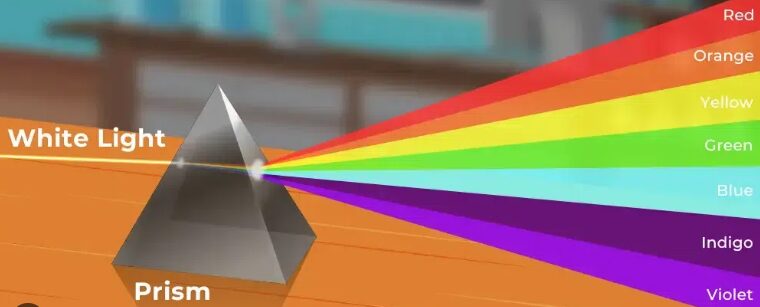Prisms
Light and Prisms: Unveiling the Colors
Have you ever wondered why a prism can turn a beam of white light into a rainbow of colors? Prisms play a fascinating role in demonstrating how light interacts with materials, especially through refraction and dispersion. Let’s explore how prisms work, the science behind them, and witness it through an interactive simulation.
What is a Prism?
A prism is a transparent optical element with flat, polished surfaces that refract light. They are typically made of glass or plastic and shaped like a triangular prism. When light passes through a prism, it bends (refracts) and can split into its component colors (dispersion).

A prism refracting white light into a spectrum of colors.
Refraction and Dispersion
Refraction
Refraction is the bending of light as it passes from one medium to another with a different density. This happens because the speed of light changes in different materials. When light enters a prism, it slows down and bends towards the normal (an imaginary line perpendicular to the surface). Upon exiting, it speeds up and bends away from the normal.
Dispersion
Dispersion occurs because different colors (wavelengths) of light bend by different amounts when refracted. Shorter wavelengths (blue/violet light) refract more than longer wavelengths (red light). This separation of colors results in the formation of a spectrum—a rainbow!
Interactive Simulation: Adjusting the Angle of Incidence
Use the slider below to adjust the angle at which the white light enters the prism. The light always hits the center of the prism. Notice how, at higher angles of incidence, the colors come closer together, and at lower angles, they spread out more.
Real-Life Applications
- Spectroscopy: Scientists use prisms to disperse light into spectra for analyzing the composition of light sources, including stars.
- Optical Instruments: Prisms are integral components in cameras, binoculars, and periscopes, manipulating light paths for various functionalities.
- Art and Decoration: Prisms and crystal ornaments create beautiful displays of colored light when illuminated.
Test Your Understanding
- Why do different colors of light refract at different angles when passing through a prism?
- How does changing the angle of incidence affect the dispersion of light through the prism?
- Can you think of natural phenomena where light is dispersed similar to a prism?
Connecting to the NGSS Standards
This content aligns with the Next Generation Science Standards (NGSS) for 8th grade:
- MS-PS4-2: Develop and use a model to describe that waves are reflected, absorbed, or transmitted through various materials.
- MS-PS4-1: Use mathematical representations to describe a simple model for waves that includes how the amplitude and wavelength of a wave are related to the energy in a wave.
Conclusion
Prisms offer a window into the hidden colors within white light, revealing the spectrum that makes up the light we see every day. By adjusting the angle of incidence in this simulation, you can see firsthand how changing the angle affects the dispersion of light. Notice how at higher angles, the colors come closer together, and at lower angles, they spread out more. Understanding how prisms work not only enriches our knowledge of optics but also illuminates the fundamental behaviors of waves and light. Keep exploring, and you’ll find prisms are just the beginning of a colorful journey in science!
